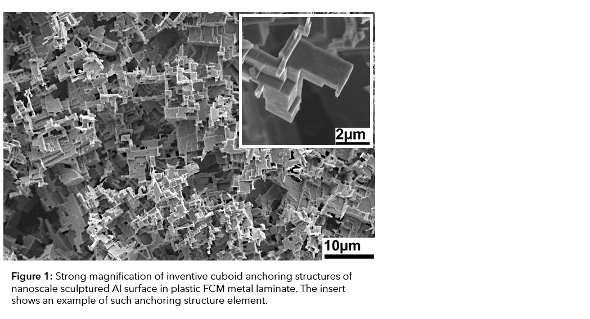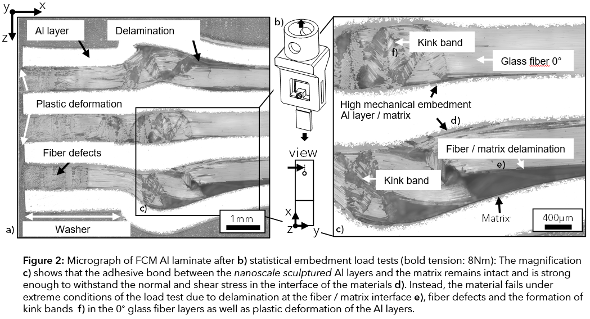International Partner Search
Innovation & Technology Offer
Plastic fiber composite aluminum laminates with high mechanical strength and low weight
Country of Origin: Germany
Reference Number: TODE20201217001
Publication Date: 11 January 2021
Summary
A German university has developed an aluminum (Al) reinforced fiber composite material (FCM) of low weight and high mechanical strength for application in aircraft construction, wind power generation, automotive industry, or boat construction. The university is looking for partners for research cooperation agreements, transfer of rights, license agreements, or know-how transfer.
Description
For lightweight construction, many industries use FCM to reduce weight while improving mechanical rigidity and strength compared to Al as a light metal.
There are several problems still not solved in the state of the art, e.g. high laminate thickness is required for the load transmission of a FCM bolt connection, leading to increased weight and space requirements as well as secondary bending of the structure. In addition, FCM behave brittle towards impact damages, since the energy introduced by an impact cannot be dissipated by local deformation alone but often creates extensive cracks and detachments of the fibers from the matrix along the entire structure. Such damage is often hardly recognizable and can lead to the total failure of the structure under repeated mechanical stress.
To mitigate such problems, FCM can be reinforced with metal layers. However, so far a stable adhesion of the metal layers to the FCM could not be realized sufficiently. Studies showed that the low adhesion of the metal layers to the FCM layers resulted in delamination at the interfaces between the layers. Conventional attempts to improve the adhesion between metal and FCM, e.g. sandblasting or anodizing Al with subsequent addition of adhesion promoters, have not fundamentally solved the problem.
To overcome the aforementioned shortcomings, a German university has developed an Al reinforced FCM offering several advantages, especially increased tensile and shear strength, increased embedding strength, and increased residual loading capacity after impact damages.
Moreover, the inventive laminates achieve a strong adhesion of Al and FCM by structuring the surfaces of the Al layers using nanoscale sculpturing (Fig. 1). The sculpted Al anchoring structures are enclosed by the matrix material of the FCM forming a mechanically rigid laminate by embedding Al within the matrix of the FCM without chemical bond. This connection cannot be separated by any load case. Delamination or total failure as observed for conventional laminates were prevented as shown in embedment load tests (Fig. 2). In fact, the matrix material or the fiber-matrix connection is now the weakest link in the chain, and no longer the matrix-metal adhesion. The inventive laminates allow a far-reaching introduction and distribution of force within the FCM.
In addition, defects like delamination can be monitored in situ by ordinary capacity measurements between the metal layer and matrix without additional sensors. Possible applications are in the fields of aircraft construction, wind power generation, automotive industry, or boat construction.
The patented technology is offered for license agreements or transfer of rights if this is preferred. Both would be suitable, when the industrial partner intends further in-house development of the technology for commercialization, which could also be supported by knowledge-transfer.
The involved university and inventors are open to discuss a research cooperation agreement with industrial partners to develop the technology towards a higher technology readiness level (TRL). The goal of such a cooperation could be to generate application specific results for the use case of the industrial partner. The partnering university offers their academic expertise in the manufacturing and testing of the Al FCM materials.


Advantages and Innovations
The Al reinforced fiber composite material offers the following advantages, which are not yet solved or adequately addressed in competing state of the art solutions:
- increased tensile and shear strength
- increased embedding strength
- increased residual loading capacity after impact damages
- very strong adhesion of metal (Al) and FCM (which is a significant improvement compared to state of the art, where detachments of the fibers from the matrix are a cause for failure)
- no hafting required at area of load introduction
- in situ monitoring for defects
Stage Of Development
Prototype available for demonstration
Stage Of Development Comment
Working prototype available / lab tested
Requested partner
Sought are industrial partners of any size (SME or MNE) from the fields of aircraft construction, wind power generation, automotive industry, or boat construction for transfer of rights, license agreements, research cooperation agreements, or know how transfer.
The offered license agreement (or transfer of rights in case of interest) would be suitable, in case an industrial partner intends further in-house development of the technology for its commercialization, which could be supported by the university by knowhow transfer.
The university involved is also open to discuss a research cooperation agreement with industrial partners in order to further develop the prototyped technology together and reach a higher TRL. Research cooperation agreements would usually include an option for the industrial partner to purchase the patent or obtain a license at later stage.
The role of the industrial partner for any type of cooperation would be the commercialization of the technology.
Cooperation offer is closed for requests
